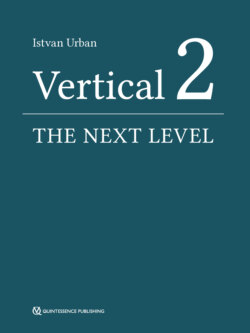Читать книгу Vertical 2: The Next Level of Hard and Soft Tissue Augmentation - Istvan Urban - Страница 21
Surgical procedure
ОглавлениеPotential risks and benefits of the VBA procedure were reviewed presurgically with all enrolled patients. Written consent was obtained from all patients prior to surgery. All participants received prophylactic systemic antibiotic coverage with 500 mg amoxicillin three times a day or, in the case of penicillin allergy, 150 mg clindamycin four times a day 24 hours prior to surgery.
A midcrestal incision was made in the keratinized mucosa of the edentulous site to be augmented, and sulcular incisions were made around the adjacent teeth. Periosteal elevators were used to raise full-thickness mucoperiosteal flaps extending at least 5 mm apical to the alveolar crest; particular care was given to sites with thin mucosa or minimal to no keratinized tissue to avoid flap perforation. To enhance access, two vertical releasing incisions were made at least one tooth away from the surgical site. The depth and location of the vertical releasing incisions as well as the technique used for flap management depended on the depth of the vestibule and the extent of the existing defect.2 For mandibular cases, lingual flaps were elevated to the mylohyoid muscle attachment, which was then bluntly separated.3
Each recipient site was decorticated using a small round bur to increase blood supply to the recipient bed. A particulate autograft was harvested with a bone scraper from intraoral sites adjacent to the defect (Osteogenics Biomedical, Lubbock, TX, USA). The amount of bone harvested was based on the size of the graft needed. Autogenous bone particulate was mixed with ABBM (Bio-Oss; Geistlich Pharma, Wolhusen, Switzerland) in a 1:1 ratio and positioned on the residual ridge to mimic the desired bone morphology.
The area to be covered by mesh was estimated using a University of North Carolina-15 (UNC-15 (probe, and an appropriately sized RPM was selected, trimmed, and placed to completely cover the graft and at least 2 mm of adjacent native bone. The mesh was stabilized on the lingual/palatal sides using titanium pins (Master-Pin; Meisinger, Neuss, Germany) or screws (Pro-fix; Osteogenics Biomedical).2 The membrane was then covered with a native collagen membrane in all cases (Bio-Gide; Geistlich Pharma).
Periosteal releasing incisions were carefully made to advance buccal flaps. In premolar sites, the mental nerve was protected, particularly in cases with severe atrophy that demanded more apically extending vertical incisions. Lingual flaps were advanced based on the location of the mylohyoid muscle attachment and were handled according to three previously described zones of interest.3
Double-layered suturing was employed to create intimate tissue adaptation and prevent membrane exposure. In this technique, horizontal mattress sutures (GORE-TEX CV-5 Suture; W. L. Gore & Associates, Flagstaff, AZ, USA) were placed 4 to 5 mm from the incision line. Then, single interrupted sutures were used to secure all flap edges. The sutures were left undisturbed for at least 2 to 3 weeks. The surgical site was allowed to heal for at least 6 months. At re-entry, limited mucoperiosteal flaps were elevated to remove the RPM and titanium pins and/or screws and to perform implant placement.
